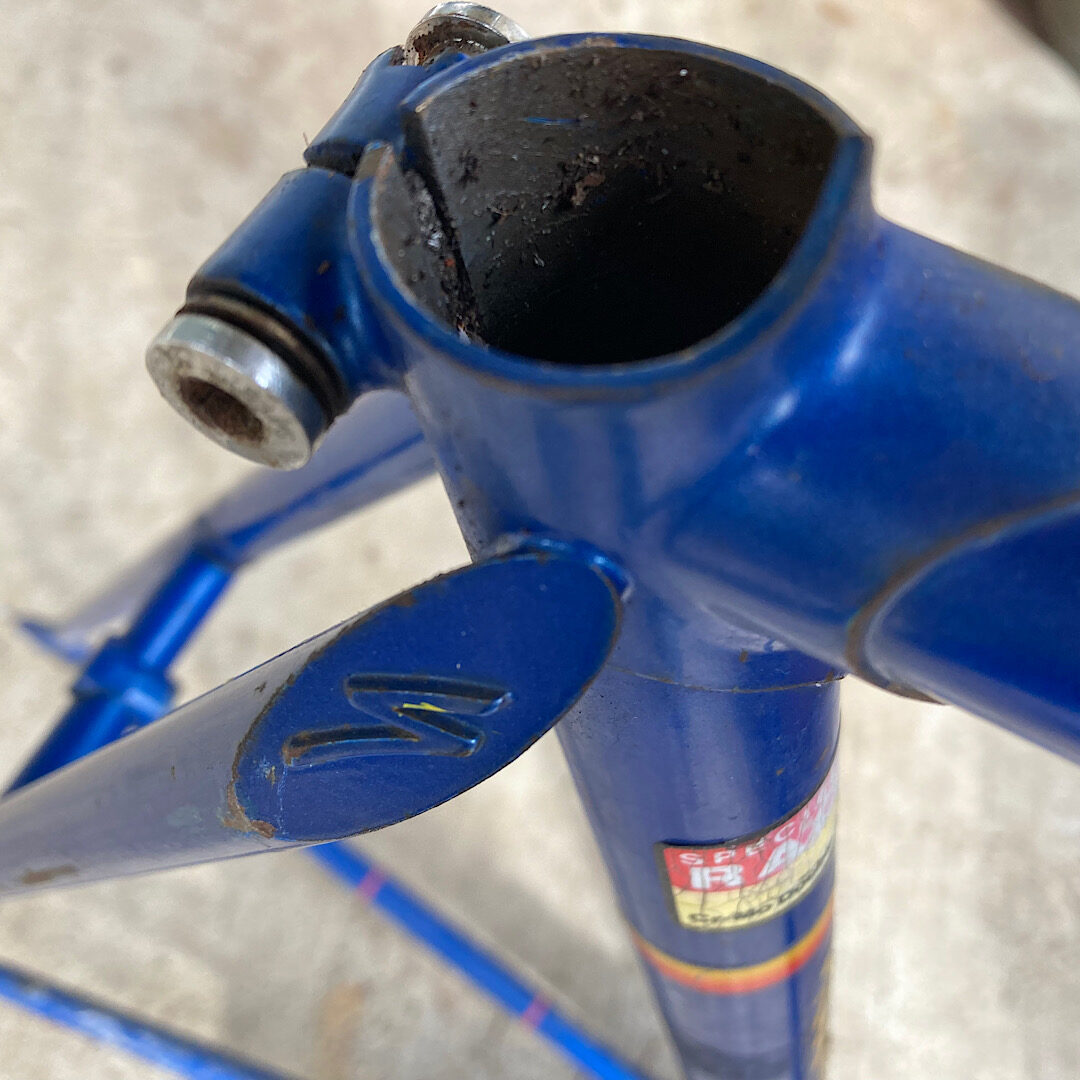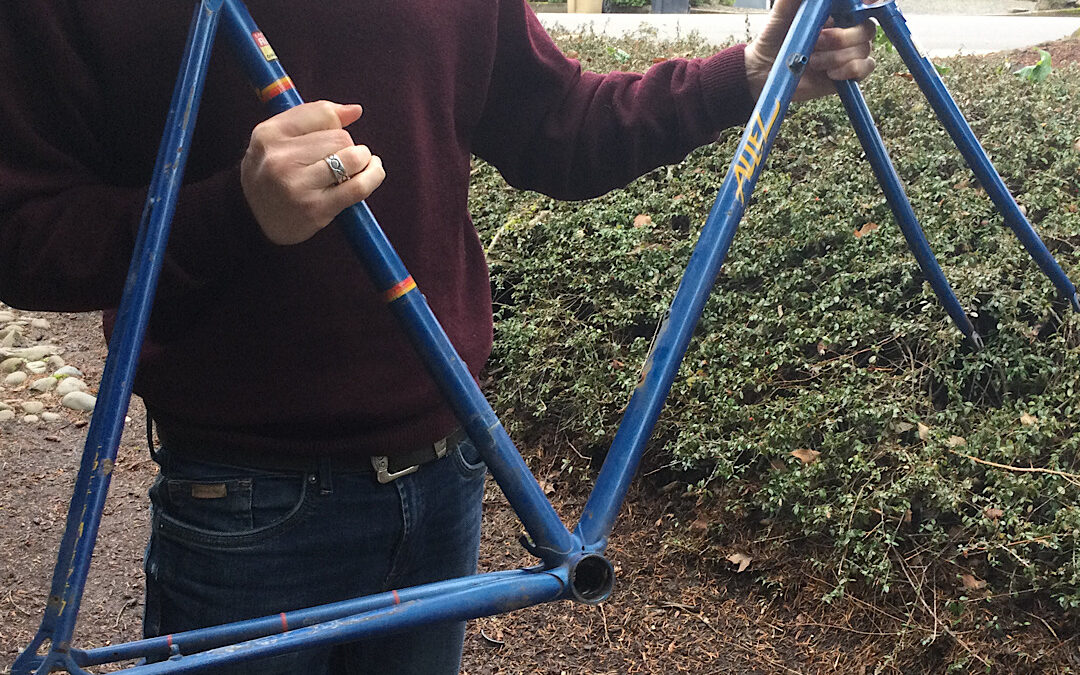Vintage Specialized Allez Restoration
If a vintage bike has been ridden for years as a commuter bike, then chances are its condition is going to cause some issues for the restorer. Riding in the elements year after year, especially through the long winters of the Northwest, means hardship for the bike as a whole for its years of service for the rider. Commuter bikes are often just a practical mode of transport, a tool to get from A to B; they are not carefully kept in original condition or lovingly displayed on weekend rides. This bike had been through years of this type of duty, and its components were stuck in place. But this vintage Specialized Allez restoration was going to prove difficult.

Dating the Bike
Before I get into the problems faced taking these components off, a note about the bike itself. I believe the man who sold it to me was not its original owner, as he moved to Portland in early 1990’s. He believed the bike was from 1988, but I’m quite sure that’s not the case. First, let me reveal the serial number: it is JS56337. Seven figures, which wasn’t a standard stamp for the Allez, as some had eight, others had fewer. The fork its also stamped with a 5, and all the Shimano components are stamped with JK, which is Shimano’s date of 1985. Looking at the serial number, the third number ( 5 ) or the final digit ( 7 ) would most likely state the year of the frame. Taking all this information into account, I would best guess it is from 1985.
The Allez Debate
I’ve looked into the complex question of where and when these Allez bikes were built in the 1980’s, and there is a lot of confusing and contradictory opinions about serial numbers and production. This page, which has a lot of useful information on Japanese-built frame dating, suggests that it is Miyata built frame. My serial number is similar to this person’s post, which seems to be from 1986. During the 1980’s, these Allez bikes were built by Miyata, 3Rensho, Toyo and then by Giant in Taiwan. It’s not easy to find exactly who built a particular Allez, but the Tange fork on my bike is stamped “Made in Japan”. Here are two interesting theories:
- I’ve read that if the Specialized stamp on the fork crown and seat lug is raised, it is from before 1986; they were recessed from then on, after that year.
- Also, if the brazed cable guides are beneath the bottom bracket, then it was built from 1987 onwards; mine are on top of the bottom bracket shell, which places it pre-1987.
I’m going with 1985.

Made in Japan sticker

Brazed cable guides on top of the shell

The raised “S” logo stamp
Value
If your Allez was built by 3Rensho in Japan, you have something very special and collectable. Identification of these bikes is tricky but they are known to have long pointed lugs, a sweeping fork crown and unpainted rear drop outs. I know mine wasn’t built by this now legendary workshop, but it is a Jim Merz edition, which has something of its own desirability. Jim Merz edition bikes ended after 1986, so my dating of 1985 seems to agree with these facts. I think. the general consensus is that Specialized were collaborating with expert frame builders and Japanese manufacturers and were building some excellent bikes, mostly with Japanese components.

The Double Seatpost
The first attempt to remove the seat post didn’t bode well. It didn’t move, and when I added more force the saddle itself began turning within the seat post! I realised that a bit of a hack job had been done, that a 1 inch stub had been fitted the saddle into the main seat post. That seems dangerous and insecure to me. The main seat post looked like it has been hammered into the frame and it wouldn’t budge. I ended up putting it into a vice and turning the frame itself, and after a good 15 minutes we finally heard the crack of the bond break.

Heat treatment
My father in law’s vice is old and heavy duty, with a secondary curved vice grip within its main body. This grip shape really helped with gripping the curvature of the seat post. With one great effort, the seat post conceded its hold. The relief of success, however, was brief. Attempts to remove the headset in a normal fashion failed, and we ended up heating it with a blower to loosen the bonding that held the lock nut tight. Securing the head tube in the vice was again necessary to release the offending lock nut.
Damage to the Crank Threads
Finally it came to pulling off the crank. The years of commuting had left both crank arms fiercely attached to the spindle, and the left crank arm refused to yield; its threads got damaged in the battle with the crank puller, which itself was brand new. With no other alternatives, I was reduced to taking out the bottom bracket cup with the spindle still attached to the arm. A Pyrrhic victory, perhaps, but at least it was off the frame. This vintage Specialized Allez restoration was not going as expected.

Tapping out the cup with a screwdriver

Finally, Repairing the Fork
How can you repair a bent fork without a precise tool? This was the question utmost in my mind about the problem I was facing. If I did my own repairs, even just bending the blade by tiny increments, would it ever be correct? Would I even make the problem worse? I have seen videos for such methods using DIY tools and articles suggesting that a pipe can be used, and there are other, rather crude methods proposed for this adjustment. Ultimately, I don’t adhere to a philosophy that every job must be done by yourself. If I don’t have the tools or experience for a particularly difficult repair, it seems more sensible to pay a fair price to someone who can do an expert job. Yes, this is the age when everyone can do everything with the help of Youtube, but we have to respect the skills and knowledge of experienced professionals. Especially if you care about your frame.

The bent blade on another wheel
The Fork Repair
In the end I took the fork down to Sellwood Cycles in Portland, who were initially sceptical that the fork could be corrected. However, after a couple of hours of careful adjustment with their fork adjustment tools, they called me and told me it was repaired. Initially they guessed that the cost would be from $25 – $40, but when I came to see their repair, they told me there would be no charge! Interestingly, only the final inch of the left blade had been bent out of shape. There was a slight ripple in the left side blade that had been damaged by a kerb or pot hole, but the repair was a success.

Sellwood Cycles

Ready for repainting




Thanks for your story & research. Just picked up the same bike, and it’s great to learn so much here. I will check to see if you posted a follow-up ‘here’s the finished bike’ story. If not, please do. Keep rollin’!
Thanks for posting, I will make a video of what happened with my Allez project soon. Cheers!
Thanks I’m glad to have an idea of what year this bike is.